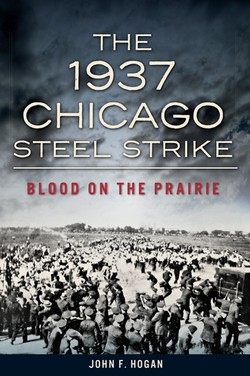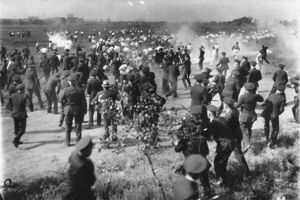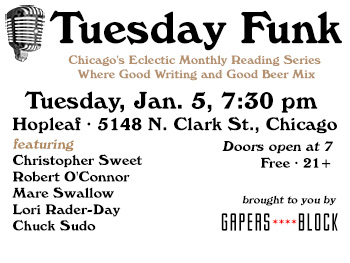| « Bookmarks | Well Read: A Solo Exhibition from Tracie Ching » |
Reviews Sun Mar 23 2014
Guns and Steel: John F. Hogan's The 1937 Chicago Steel Strike
 John F. Hogan establishes a couple of his credentials right at the outset of his new book: "I come from a police family and worked a summer break from college on the open-hearth furnaces at Republic Steel's South Chicago plant," he writes. Even given this background, though, he says it took years for him to first happen across the 1937 Republic strike's essential stats: 40 men wounded by police fire; 10 killed, most shot in retreat; dozens more beaten by clubs. In The 1937 Chicago Steel Strike: Blood on the Prairie, he reminds us of this deadly episode in labor history and opens a window into a time when any given strike was not just a bargaining tactic but potentially a life-and-death battle.
John F. Hogan establishes a couple of his credentials right at the outset of his new book: "I come from a police family and worked a summer break from college on the open-hearth furnaces at Republic Steel's South Chicago plant," he writes. Even given this background, though, he says it took years for him to first happen across the 1937 Republic strike's essential stats: 40 men wounded by police fire; 10 killed, most shot in retreat; dozens more beaten by clubs. In The 1937 Chicago Steel Strike: Blood on the Prairie, he reminds us of this deadly episode in labor history and opens a window into a time when any given strike was not just a bargaining tactic but potentially a life-and-death battle.
Metaphors of war are not even a little hyperbolic here. As steel companies and other manufacturers quaked before the tide of union organization rolling through the 1930s, they accumulated massive arsenals of clubs, live ammunition, and, especially, the then-recent innovation of tear-gas grenades. These armed not just the plants' guards, but often the local police forces as well, in line with a cooperative spirit that also occasionally found police enjoying free lunches and other perks at the expense of the companies they were protecting.
Given this kind of collusion--further enabled by City Hall and by articles in the Tribune and other outlets that made no secret where their sympathies lay--it might seem a wonder that so many of the workers at Republic Steel felt they had any chance of success. But they had their own sources of strength in the recently formed Congress of Industrial Organizations (CIO), headed by the formidable John L. Lewis.
Hogan has a wonderful eye for character, and Lewis ("a cartoonist's godsend," with "eyebrows sufficiently overgrown to accommodate three faces") is one of the most outsize characters in the book. Prone to self-mythologizing, Lewis seems to have been fueled by a love of power as much as a passion for workers' rights, but there's no question that he was enormously influential in organizing entire industries that previous unions--up to then formed around "skilled" industries such as carpentry and plumbing--had rejected. By 1937, the leviathan U.S. Steel had signed a union contract and the fight to unionize the half-dozen smaller players known as "Little Steel" was well underway.
As a foil, Lewis had Republic Steel head Tom Girdler, as blustery in his own way as Lewis. (Where Lewis spoke of punching out a mule that blocked his way in a coal mine as a boy, Girdler boasted proudly in his autobiography about slamming a subordinate's head against a plant floor after the man swore at him.) Hogan initially frames the book's conflict as something of a personality clash writ large, and following these two characters is an exceedingly reader-friendly way to carry us through the complex labor and political landscape of the mid-1930s.
By the time the key battle at Republic starts, Hogan has more or less dropped this framing device, although he does call it back one more time in the book's last few paragraphs. It's not an entirely elegant structure, but you can see why he abandons his initial conceit once the people on the ground in Chicago begin to crowd into the frame. There are plenty of fascinating figures here, too, and Hogan digs up a wealth of primary sources and archival photos to bring them to life.
Among the strikers: Joe Weber, a Communist Party member who went by at least six other names and whom the government had tried to deport without success--perhaps because they knew only that he was rumored to have come from some Balkan country; organizer George Patterson, whose never-published autobiography supplies almost a blow-by-blow account of the day; and not a few women on the front lines, including the 4'11" social worker Lupe Marshall and the pregnant Ada Leder, who both had their own encounters with police and lived to record their own stories.
 On the government side we have Mayor Edward J. Kelly, who announced that peaceful picketing would be allowed but then did nothing to communicate that stance to the police. (He also had the now-familiar mayoral talent of being away on vacation during times of turmoil.) At their head was Captain James Mooney, whose command of his 900 patrolmen seems to have been deeply informed by his hatred and terror of Communists--who he believed were not only behind this strike but were, he's quoted as saying, "here to undermine the government and assault policemen. It seems to me that murder is just in their nature." Patrolmen like the gleefully perjurious George Higgins were only too glad to take their cues from Mooney, contributing (unconfirmed) tales of crutches used as slingshots, nickel-plated revolvers flashing in the sun, and ladies with their purses full of pepper.
On the government side we have Mayor Edward J. Kelly, who announced that peaceful picketing would be allowed but then did nothing to communicate that stance to the police. (He also had the now-familiar mayoral talent of being away on vacation during times of turmoil.) At their head was Captain James Mooney, whose command of his 900 patrolmen seems to have been deeply informed by his hatred and terror of Communists--who he believed were not only behind this strike but were, he's quoted as saying, "here to undermine the government and assault policemen. It seems to me that murder is just in their nature." Patrolmen like the gleefully perjurious George Higgins were only too glad to take their cues from Mooney, contributing (unconfirmed) tales of crutches used as slingshots, nickel-plated revolvers flashing in the sun, and ladies with their purses full of pepper.
The coroners' reports, however, tended to speak for themselves. So did the photographic evidence. The wide-open prairie makes an almost surreal backdrop for the many scenes of police standing over fallen marchers, clubs ready to deliver another blow. Press captions at the time framed photos of police dragging the wounded away as carrying them to safety and medical aid, although firsthand accounts and hospital records make clear that in many cases the victims would be tossed into paddy wagons and driven to jail or to far-distant hospitals, sometimes after a leisurely cruise around the city. In one case, such rough handling removed the tourniquet from a man shot in the leg, hastening if not causing his death; in other instances, emergency-room personnel reported police badgering them to let the wounded be taken to jail.
The press was forced to shift its tone somewhat about a week after the massacre, when Paramount finally released a newsreel documenting the police's "extreme brutality" in action. Still, many still bought the policemen's claims that they shot and struck in self-defense only; a coroner's jury classed all the deaths as "justifiable homicide," although reports from both a Senate subcommittee's investigation and the Citizens Joint Commission strongly censured the police's and the city's conduct.
The strikers' deaths are appallingly sad in their senselessness; sadder still is how little they seem to have changed anything in terms of the city's and the nation's police response to protest. Republic was ordered to reinstate thousands of strikers and pay damages to the families of the injured and dead--and after four years of further organizing, was forced to sign a union contract--but no policemen were ever charged with a crime; among the strikers, about 50 were charged and fined for unlawful assembly.
Even if it marked no great national turning point, the story of the Memorial Day massacre is still manifestly a useful story to have retold today, especially in Hogan's vivid but evenhanded telling. Among other things, it serves as a reminder to cast a skeptical eye on media coverage of modern protests of all kinds, and a warning as to how easily police action can create an accountability-free zone for itself. Which is not to say that The 1937 Chicago Steel Strike will strike a chord only with labor-activist types. This is not a polemic or an academic text but a gripping narrative that happens to be impeccably sourced, and it ought to make a compelling read for any history buff or general Chicagophile.









